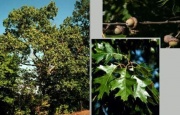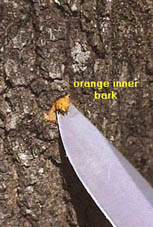Difference between revisions of "Black oak"
m (Text replace - "== Authority ==" to "== Sources Checked for Data in Record ==") |
|||
| (2 intermediate revisions by the same user not shown) | |||
| Line 1: | Line 1: | ||
| − | [[File:Quercusvelutinaf5.jpg|thumb|Black oak | + | [[File:Quercusvelutinaf5.jpg|thumb|Black oak ''Quercus velutina'']] |
| − | |||
| − | ''Quercus velutina'']] | ||
== Description == | == Description == | ||
The black oak, ''Quercus velutina'' (not ''Quercus nigra''), has a black or dark brown bark and is native to the Eastern and Midwestern part of the United States. These small, but fast growing trees grow on rocky hillsides and sandy ridges. While the tree is occasionally used for lumber, its most important commercial product is a yellow dye obtained from the trees orange-yellow inner bark. The dye bark was named [[quercitron]] in the late 18th century and brought to Europe as a substitute for [[weld dye]]. The bark also contains tannins that were used in the leather industry. Quercitron contains three colorants: [[quercetin]], quercetagetin and [[flavine]]. The dye is extracted from the black oak bark with boiling water. The outermost layer gives a bright yellow while the inner bark gives a darker oranges and tans. | The black oak, ''Quercus velutina'' (not ''Quercus nigra''), has a black or dark brown bark and is native to the Eastern and Midwestern part of the United States. These small, but fast growing trees grow on rocky hillsides and sandy ridges. While the tree is occasionally used for lumber, its most important commercial product is a yellow dye obtained from the trees orange-yellow inner bark. The dye bark was named [[quercitron]] in the late 18th century and brought to Europe as a substitute for [[weld dye]]. The bark also contains tannins that were used in the leather industry. Quercitron contains three colorants: [[quercetin]], quercetagetin and [[flavine]]. The dye is extracted from the black oak bark with boiling water. The outermost layer gives a bright yellow while the inner bark gives a darker oranges and tans. | ||
| − | [[File:Image3_802515.jpg|thumb|Black oak | + | [[File:Image3_802515.jpg|thumb|Black oak ''Quercus velutina'']] |
| − | |||
| − | ''Quercus velutina'']] | ||
== Synonyms and Related Terms == | == Synonyms and Related Terms == | ||
| Line 14: | Line 10: | ||
black oak (''Quercus velutina''); water oak (''Quercus nigra''); chêne noir américain (Fr.) ; yellow oak; American oak; quercitro | black oak (''Quercus velutina''); water oak (''Quercus nigra''); chêne noir américain (Fr.) ; yellow oak; American oak; quercitro | ||
| − | == | + | == Physical and Chemical Properties == |
| − | Medium trees growing to 25 m. Bark=rough, nearly black with deep vertical furrows and horizontal breaks. The inner bark is bright yellow-orange. Leaves=shiny green with 5 to 7 lobes. Fruit=ovoid acorns with bowl shaped cap maturing in late summer every 2 years. | + | * Medium trees growing to 25 m. |
| + | * Bark=rough, nearly black with deep vertical furrows and horizontal breaks. | ||
| + | * The inner bark is bright yellow-orange. | ||
| + | * Leaves=shiny green with 5 to 7 lobes. | ||
| + | * Fruit=ovoid acorns with bowl shaped cap maturing in late summer every 2 years. | ||
== Additional Images == | == Additional Images == | ||
<gallery> | <gallery> | ||
| − | File:52_Yellow Oak_Rad_100X.jpg|Yellow oak (''Quercus velutina'') | + | File:52_Yellow Oak_Rad_100X.jpg|Yellow oak (''Quercus velutina'')<br> radial section |
| − | File:52_Yellow Oak_Tan_100X.jpg|Yellow oak (''Quercus velutina'') | + | File:52_Yellow Oak_Tan_100X.jpg|Yellow oak (''Quercus velutina'')<br> tangential section |
| − | File:52_Yellow Oak_Tran_100X.jpg|Yellow oak (''Quercus velutina'') | + | File:52_Yellow Oak_Tran_100X.jpg|Yellow oak (''Quercus velutina'')<br> transverse section |
</gallery> | </gallery> | ||
| − | + | ==Resources and Citations== | |
| − | == | ||
* ''Dictionary of Building Preservation'', Ward Bucher, ed., John Wiley & Sons, Inc., New York City, 1996 Comment: lists tree as ''Quercus velutina'' | * ''Dictionary of Building Preservation'', Ward Bucher, ed., John Wiley & Sons, Inc., New York City, 1996 Comment: lists tree as ''Quercus velutina'' | ||
| Line 33: | Line 32: | ||
* John and Margaret Cannon, ''Dye Plants and Dyeing'', Herbert Press, London, 1994 | * John and Margaret Cannon, ''Dye Plants and Dyeing'', Herbert Press, London, 1994 | ||
| − | * ''Encyclopedia Britannica'', http://www.britannica.com Comment: "black oak" | + | * ''Encyclopedia Britannica'', http://www.britannica.com Comment: "black oak" [Accessed September 19, 2003]. lists tree as ''Quercus velutina'') |
| − | * | + | * Virginia Tech Dendrology website at www.fw.vt.edu/dendro/dendrology/main.htm (accessed Oct. 8, 2005) |
| − | * Wikipedia | + | * Wikipedia: http://en.wikipedia.org/wiki/Black_oak (Accessed Oct. 8, 2005) |
* Random House, ''Webster's Encyclopedic Unabridged Dictionary of the English Language'', Grammercy Book, New York, 1997 | * Random House, ''Webster's Encyclopedic Unabridged Dictionary of the English Language'', Grammercy Book, New York, 1997 | ||
Latest revision as of 07:40, 8 May 2022
Description
The black oak, Quercus velutina (not Quercus nigra), has a black or dark brown bark and is native to the Eastern and Midwestern part of the United States. These small, but fast growing trees grow on rocky hillsides and sandy ridges. While the tree is occasionally used for lumber, its most important commercial product is a yellow dye obtained from the trees orange-yellow inner bark. The dye bark was named Quercitron in the late 18th century and brought to Europe as a substitute for Weld dye. The bark also contains tannins that were used in the leather industry. Quercitron contains three colorants: Quercetin, quercetagetin and Flavine. The dye is extracted from the black oak bark with boiling water. The outermost layer gives a bright yellow while the inner bark gives a darker oranges and tans.
Synonyms and Related Terms
black oak (Quercus velutina); water oak (Quercus nigra); chêne noir américain (Fr.) ; yellow oak; American oak; quercitro
Physical and Chemical Properties
- Medium trees growing to 25 m.
- Bark=rough, nearly black with deep vertical furrows and horizontal breaks.
- The inner bark is bright yellow-orange.
- Leaves=shiny green with 5 to 7 lobes.
- Fruit=ovoid acorns with bowl shaped cap maturing in late summer every 2 years.
Additional Images
Resources and Citations
- Dictionary of Building Preservation, Ward Bucher, ed., John Wiley & Sons, Inc., New York City, 1996 Comment: lists tree as Quercus velutina
- John and Margaret Cannon, Dye Plants and Dyeing, Herbert Press, London, 1994
- Encyclopedia Britannica, http://www.britannica.com Comment: "black oak" [Accessed September 19, 2003]. lists tree as Quercus velutina)
- Virginia Tech Dendrology website at www.fw.vt.edu/dendro/dendrology/main.htm (accessed Oct. 8, 2005)
- Wikipedia: http://en.wikipedia.org/wiki/Black_oak (Accessed Oct. 8, 2005)
- Random House, Webster's Encyclopedic Unabridged Dictionary of the English Language, Grammercy Book, New York, 1997
- The American Heritage Dictionary or Encarta, via Microsoft Bookshelf 98, Microsoft Corp., 1998




